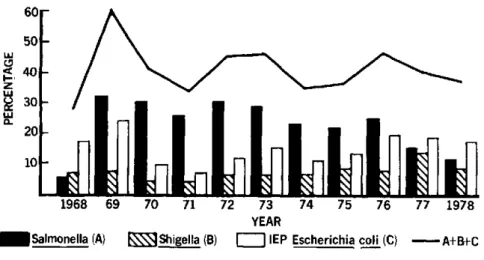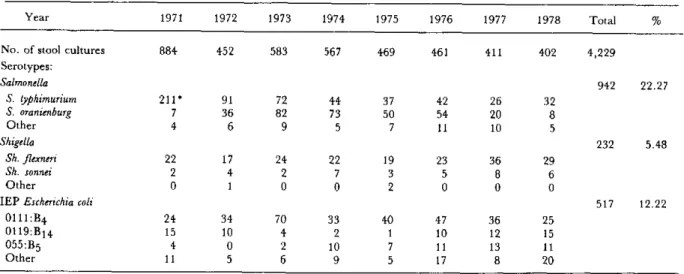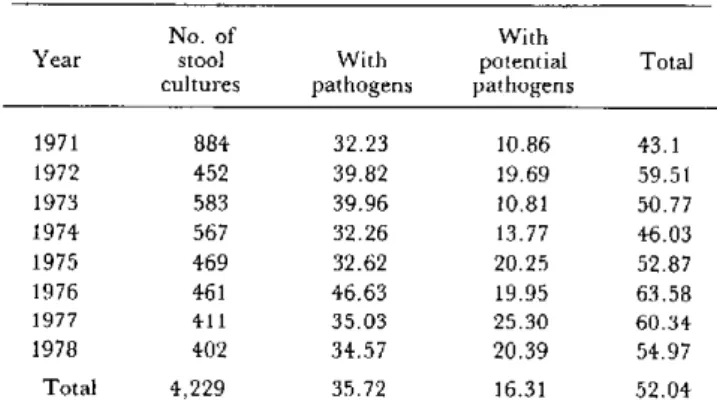Isolation of Pathogenic Enterobacteria in Children
with Acute Diarrhea, Argentina, 1971-1978
Between 1971 and 1978 a total of 4,229 stool cultures were made on children with acute diarrhea who were being treated in hospitals in Buenos Aires and its envi-rons. The ages of the children ranged from the first days of life to five years. Specimens were collected by means of a rectal swab before the administration of any treatment with antimicrobial drugs, and the material was processed within three hours of its collection. For the isolation and biochemical and serological identification of the bacteria, methods developed in recent decades for the culture of aerobic and anaerobic bacteria were used. The antigenic structure of Salmonella, Shigella, and infantile enteropatho-genic (IEP) Escherichia coli was determined by means of immune sera prepared by the Carlos G. Malbrán Nation-al Institute of Microbiology.
Invasion of the intestinal epithelium is the means by which Salmonella, Shigella non dysenteriae, and E. coli entero-invasive serotypes penetrate and damage the epithelial mucosa, thus provoking the secretion of water and elec-trolytes, which leads to diarrhea. E. coli also produce en-terotoxins but the modus operandi of IEP E. coli is not yet known. The above-mentioned serotypes were the first in-volved in infant diarrheas. Some acted by an invasive mechanism similar to that mentioned for Salmonella and Shigella and others by the production of enterotoxins. Some authors discuss their etiological importance since they do not find any relationship with either of those two mechanisms.
With respect to potentially pathogenic germs (Staphylo-coccus aureus, Pseudomonas aeruginosa, Providence, and Aero-monas) their incidence is considered since they are not nor-mal constituents of the intestinal flora. During episodes of acute diarrhea, the ecological imbalance produced in the intestinal flora favors adhesion and colonization by these opportunist bacteria. When the physical conditions of the host are compromised, as in the case of malnourished children or children with deficient defense mechanisms, these microorganisms may spread to other sites. Although their pathogenic role in acute diarrhea is not yet accurate-ly known, some of their biological characteristics could implicate them as causes of bacterial infectious diarrheas. Staphylococcus aureus can induce secretion of fluids and electrolytes by means of two mechanisms: inflammation and production of enterotoxins.
Five enterotoxins of S. aureus (A, B, C, D, and E) have been described, and many of them have been incrimi-nated in food poisonings. In the United States it has been reported that between 69 and 75 per cent of the outbreaks are related to A or A and D toxins. Specifically,
entero-toxin B induces a secretory mechanism in the small intes-tine of rats and leaves the absorption mechanism intact.
The approach that regards a strain of staphylococcus that produces coagulase as pathogenic is not always valid since, as Breckinridge and Bergdoll1point out, in a case of food poisoning, a coagulase-negative enterotoxin pro-ducing Staphylococcus was isolated.
Pseudomonas aeruginosa is also capable of producing ente-rotoxins with a capacity to induce an accumulation of fluid in the small intestine of rabbits; these are apparently different from other Pseudomonas toxins (hemolysin, pro-tease, lecithinase, or lethal toxin).
Foremost among the bacteria that play an important role in acute diarrheas are the Enterobacteriaceae, some members of the genus Vibrio and the potentially patho-genic group. The importance of bacterial toxins is also known since some of them are produced by microorgan-isms so far considered part of the "normal flora," for ex-ample, E. coli that does not belong to the IEP group and Klebsiella pneumoniae. In recent years the existence of a new group of viruses known as "rotavirus" or "duovirus," which are responsible for many of these diarrheal diseases, has been demonstrated.
This article presents the results of the isolation of ente-robacteria traditionally considered enteropathogenic-Salmonella, Shigella, and IEP E. coli-isolated from chil-dren with acute diarrheal diseases. At the same time the potential enteropathogens and the associations between the two groups were studied.
Figure 1 presents the comparative percentages of isola-tions of Salmonella, Shigella, and IEP E. coli in the period 1968-1978. The genus Salmonella predominates, with val-ues ranging between 20 and 30 per cent in the period 1971-1976 although a downward trend is to be noted in the following two years in which the figures fell to 13.6 and 11.2 per cent. Next in importance is the IEP E. coli group, with marked annual fluctuations, which range be-tween 6.1 and 18.4 per cent. In the main, the genus Shigel-la shows a low incidence and a steady range of between 4.8 and 6 per cent in 1972-1976 although subsequently there was an increase of 10.7 and 8.7 per cent, respective-ly.
Taking the three genera together, an etiological agent was detected in 40 per cent of the stool cultures analyzed
1
Breckinridge, J. C., and M. S. Bergdoll. Outbreak of foodborne gastroenteritis due to a coagulase-negative enterotoxin producing
Staphylococcus. N EngJ Med 284:541, 1971.
Figure 1. Percentages of pathogenic enterobacteria isolated from children with acute diarrhea, Argentina, 1968-1978.
60-50
soL
w ¡40 z w u 30 w uJ
20
10
1968 69 70 71 72
~Salmonella (A) Shigella (B)
73 74 75 76 77 1978
YEAR
E
IEP Escherichia coli (C) -A+B+CFigure 2. Annual evolution, in percentages, of Salmonella typhimurium (STM) and Salmonella oranienburg (SO) isolated from stool cultures, Argentina, 1966-1978.
35r-
30-w
C.
1-Z w si a.
25-
20-
153-
10-5
e
_ .
s*.s
1-~~~~~1.
J
J
-¿- )- ,
;:
+--Y
...1966 67 68 69 70 71 72 73
YEAR
Salmonella (total) - STM ...
since 1970. Up to 1968, the group most frequently in-volved was IEP E. coli, which peaked in 1969 with 24.3 per cent and in subsequent years did not exceed 18.4 per cent. In 1969, the peak level (60 per cent) of isolations of enteropathogens was reached, due to an increase in the
incidence of the IEP E. coli group, and Salmonella (32 per cent), which up to 1968 had remained below 6 per cent.
An analysis of the results of Salmonella isolations in 1969 showed that 84.7 per cent of the strains represented solely
the serotype S. yphimnurium (STM). This predominance, which persisted up to 1971, when STM represented 93.3 per cent of all Salmonella, was due to an epidemic outbreak
that spread to various areas of Argentina. All the health
centers in which acute diarrheal diseases were
investi-/ / - -
---1
1 a 1 *
74 75 76 77 1978
SO
---gated-for example, in Tucumán, Rosario, and the Prov-ince of Buenos Aires-reported similar results that agree with the observations published by WHO2 concerning the prevalence of that serotype in the world in both humans and animals.
Beginning in 1972 isolations of the STM serotype be-gan to decline while the findings of another serotype S. oranienburg (SO) gradually increased and in the years sub-sequent to 1976 exceeded those of STM. Figure 2 shows the annual changes in STM and SO in percentages of iso-lations from the stool cultures analyzed. In 1976 there was
2
Surveillance of Salmonella other than S. typhi and S. paratyphi, 1971.
Weekly Epidem Rcc 48:385-388, 1973. 8
e
Table 1. Annual distribution of the principal serotypes of Salmonella, Shigella, and infantile enteropathogenic Escherichia coli.
Year 1971 1972 1973 1974 1975 1976 1977 1978 Total % No. of stool cultures 884 452 583 567 469 461 411 402 4,229 Serotypes:
Salmonella 942 22.27
S. typhimurium 211' 91 72 44 37 42 26 32
S. oranienburg 7 36 82 73 50 54 20 8
Other 4 6 9 5 7 11 10 5
Shigella 232 5.48
Sh. flexneri 22 17 24 22 19 23 36 29
Sh. sonnei 2 4 2 7 3 5 8 6
Other 0 1 0 0 2 0 0 0
IEP Escherichia coli 517 12.22
0111:B4 24 34 70 33 40 47 36 25 0119:B14 15 10 4 2 1 10 12 15
055:B5 4 0 2 10 7 11 13 11
Other 11 5 6 9 5 17 8 20
'The figures correspond to the number of strains isolated.
a reversal of the situation with SO decreasing while STM again predominated, although the total figure for
Salmo-nella tended to decrease.
Table 1 shows the annual distribution of the most fre-quent serotypes of Salmonella, Shigella, and IEP E. coli. Of the four subgroups of Shigella investigated, that of Sh. flex-neri was most frequently found, serotype 2 and Sh. sonnei predominating. The remainder were Sh. boydii, since no Sh. dysenteriae were isolated.
With respect to IEP E. coli, the Ol111:B4 was the most frequent serotype followed by 0119:B1 4 and 055:B5. Smaller proportions of the remaining serotypes were found.
With respect to Salmonella the serotypes most frequently obtained were STM and SO while others, like S. typhi, S. panama, S. anatum, and S. newport, were less frequent.
Table 2 presents the findings of potentially pathogenic bacteria. As may be seen, the values of Pseudomonas are significant, high in the first three years and with a
tenden-Table 2. Annual prevalence of potentially pathogenic bacteria in children with diarrheal diseases.
Providence, No. of Staphylococcus Pseudo- Aeromonas,
Year stool aureus monas and others Total
cultures % % %
1971 884 3.61 14.59 1.35 19.55
1972 452 7.07 28.98 1.54 37.59
1973 583 5.66 12 1.88 19.54
1974 567 10.75 7.05 1.94 19.74
1975 469 17.05 8.31 4.67 30.03
1976 461 16.26 9.54 2.38 28.18
1977 411 17.27 10.94 4.86 33.09
la
1978
402
13.68
12.68
3.48
29.85
Total 4,229 10.38 12.39 3.14 25.91cy to decrease up to 1976. From 1977 their proportion in-creased to 12.6 per cent. It is noteworthy that in the years in which there was an increase in the isolations of Pseudomonas, the increase was correlated with a decrease in the findings of S. aureus and that over a period of eight years the average values were similar for the two genera. The genus Aeromonas has recently been incriminated as the causal agent of acute diarrheas in Asian countries.3
It has been demonstrated that 11 strains of Aeromonas iso-lated from children with diarrhea in Ethiopia produced enterotoxins. Our data show a low incidence of this group and of the Providence group.
S. aureus fluctuated between 3.6 and 17.2 per cent of the total stool cultures analyzed. If the figures for Providence and Aeromonas, which are potentially pathogenic, are added, the total figure is 25.9 per cent for this group of microorganisms.
The frequency of the simultaneous isolations of the enterobacteria traditionally considered pathogenic and those considered potentially pathogenic is of interest. Table 3 shows that the general average of combinations which include two or three strains is 12.2 per cent. Of this proportion, more than half (6.2 per cent) is due to the concurrence of one enteropathogenic and one potentially enteropathogenic bacterium, followed by the association of two enteropathogens (3.3 per cent). The data so far pre-sented are for the total strains isolated in the stool cultures made.
Table 4 presents an analysis of the prevalence of the two groups of pathogenic and potentially pathogenic bac-teria in the children studied. The differences between these and the foregoing figures are due to the associations
3
Ljunch, A., M. Popoff, and T. Wadstrom. Aeromonas hydrophila in
acute diarrheal disease.J Clin Microbiol 6:96-100, 1977.
Table 3. Annual distribution of associations of pathogenic enterobacteria and potentially pathogenic bacteria
in children with diarrheal diseases.
Percentage of associations
Year No. of of two bacteria of three Total stool bacteria a + b cultures a b c d + c + d 1971 884 1.9 6.56 0.57 0.75 9.84 1972 452 3.54 7.96 1.55 2.65 15.70 1973 583 5.32 6.35 1.37 1.37 14.41 1974 567 1.94 3.88 0.35 1.23 7.41 1975 469 2.98 5.97 1.91 1.70 12.57 1976 461 6.07 6.72 1.30 0.65 14.74 1977 411 3.64 5.11 1.46 4.86 15.08 1978 402 2.48 6.96 0.74 1.24 11.44 Total 4,229 3.35 6.17 1.09 1.65 12.27 a) Between two recognized pathogens.
b) Between one recognized and one potential pathogen. c) Between two potential pathogens.
d) Between three bacteria with possible combinations of pathogens and potential pathogens.
Table 4. Prevalence of pathogenic and/or potentially pathogenic agents in children with diarrheal diseases.
No. of With
Year stool With potential Total cultures pathogens pathogens
1971 884 32.23 10.86 43.1 1972 452 39.82 19.69 59.51 1973 583 39.96 10.81 50.77 1974 567 32.26 13.77 46.03 1975 469 32.62 20.25 52.87 1976 461 46.63 19.95 63.58 1977 411 35.03 25.30 60.34 1978 402 34.57 20.39 54.97 Total 4,229 35.72 16.31 52.04
of bacteria in one and the same child. More than 35 per cent of the patients with acute diarrheal diseases presented enteropathogenic germs. If the children in which
poten-tially pathogenic bacteria were found are also taken into consideration and if these bacteria actually cause diar-rhea, then in half the children (52 per cent) the diarrheal
symptoms could be attributed to a bacterial agent. It should be emphasized that there is a need to complete this study with research into the true function of potential-ly pathogenic bacteria in the pathology of diarrheal dis-eases, since their mere presence in a stool culture does not prove a cause and effect relationship.
(Source: Eiguer, T., N. Binsztein, and G. Spizzamiglio, Enterobacteria. Archivos Argentinos de Pediatría 78 (3): 354-362, 1980; Boletín Epidemiológico Nacional, Publication of the Office of National Disease Prevention and Control, and Vigilancia Epidemiológica, Ministry of Public Health and the Environment, Argentina, No. 9, 1981.)
Editorial Comment
Laboratory work is one of the fundamental aspects of epidemiological surveillance. The organized collection and prompt dispatch of specimens to laboratories must be the objective of day-to-day practice. The isolations made should be regularly analyzed so the services that treat children with acute diarrhea can do so on the basis of a better knowledge of the agent, which makes for better de-cisions in the diagnosis, treatment, and prevention of this group of diseases.
The epidemiological use of the laboratory, as is being done in Argentina at the Malbrán Laboratory, is a ration-al approach to the utilization of this vration-aluable resource. It is also important to increase the exchange of information among countries of the Region.
Social Factors in Malaria Transmission and Control
The Working Group on Social Sciences Applied to Health of the PAHO Advisory Committee on Medical Research (ACMR) has prepared, in accordance with the mandate assigned to ACMR, a Latin American Bibliography of Social Sciences Applied to Health. It has also made a study of the social and economic factors that influence malaria
transmission and control, in which it pinpoints those that are conducive to more efficient organization and planning of malaria control programs.
The recommendations of the Working Group, which were included in the ACMR report (Caracas, April
1982), cover the following:
10


